Lesson 11 (2)
4. THE JAPANESE THUMB TIE
I first saw this thumb tie performed by Asahi, the Japanese magician, a number of years ago. His presentation of it made it a work of art. His co-ordination of movements was so perfect that he could produce his effect right in the midst of the audience as well as on the stage. Ten Ichi, another Japanese performer, produced this same effect also.
The experiment created a sensation among magicians, and many solutions to the secret have been brought forth, some good, some mediocre. The method which I describe here is the most practical method and the one which is favored by the Japanese magicians. The Japanese magicians, however, use twine or rope bound with rice paper, where as I have found pipe cleaners to be very satisfactory and need no preparation. Instead of tying the thumbs with ropes, I use the wiring method. This is just as effective as tying.
First, I shall describe the pipe cleaner method and then I shall teach you how to prepare ropes with rice paper to be used in the original Japanese tying method.
EFFECT:
Performer has his two thumbs securely tied together with two cords. He rapidly passes solid hoops onto his arms and removes them, showing his thumbs to be tied all the while. He also passes his thumbs through canes, rods, a person's arm, etc., in a most mysterious manner.
PARAPHERNALIA:
1--A package of pipe cleaners. These can be purchased at any cigar store.
2--Three rings. Wooden hoops, such as women use in doing fancy work, are suitable. Use a large size hoop. Large nickeled rings, about 6 to 8 inches in diameter, such as magicians use in the linking ring trick, are especially adapted to this effect. The rings must be large enough to slip over the hands onto your arms readily.
3--A wooden pole about 5 feet long, or a piece of bamboo fishing pole the same length, or a cane, or broom.
SECRET AND PATTER:
To Prepare:
Take three pipe cleaners and twist them around each other to make a twisted cord, fairly large in diameter. Prepare another cord in the same manner, using three more pipe cleaners. Figure 31.
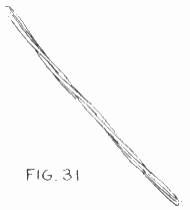
To Perform:
Request a spectator to come up from audience to assist you.
"Many people give much credit to the supernatural, and it seems that in Magic much of the work is supernatural. However, it only appears to be supernatural. In reality it depends on natural laws. We may not understand the law at work, but it is functioning nevertheless. A hundred years ago if you were to have exhibited a radio and picked up messages from the air, you would have been considered supernatural and the messages would have been regarded as spirit voices. It seems incredible that waves can pass through solid objects, yet they do. An X-ray machine, for instance, sends its rays through the human body and makes objects visible through the solid body. Many years ago a famous Japanese magician discovered this law of the penetration of solid objects and demonstrated it to his audiences in a peculiar manner. With the
assistance of this gentleman here I am going to show you how the Japanese worked." Pick up the two prepared cords of pipe cleaners.
"These are wire cords covered with a cloth material so that they will not cut into the skin of my hands. Will you, sir, hold them a moment and examine them to make sure that they are merely wires wrapped together?"
Hand spectator one of the cords.
"Take one of the cords, sir, and wrap or bind my two thumbs together securely. Wire them together as tightly as you choose, without hurting me too much, of course." Show hands, both sides, fingers spread wide apart.
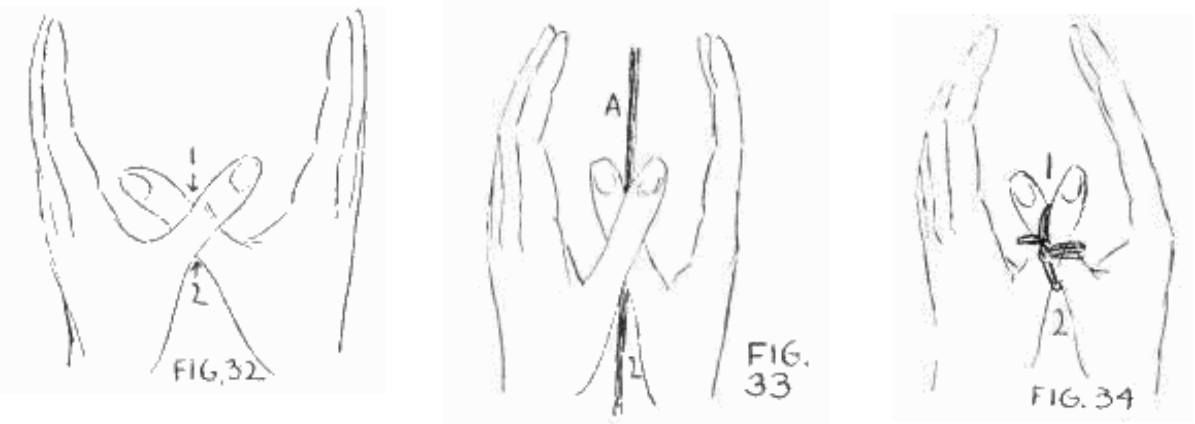
Cross your thumbs — the left one over the right. Figure. 32.
"I'll place my thumbs on the cord."
Have spectator hold cord so that you can place thumbs on it as shown in Figure 33.
"Now, bring the ends together at the top and wire them together tightly."
Spectator twists ends of cord together, thus tying the two thumbs securely together. Figure 34.
IMPORTANT:
While spectator is wiring your thumbs you have an important move to make, unknown to him. You must get slack in the cord though to all appearances your thumbs are bound tight together.
By moving your thumbs backward and forward with your joints acting as a pivot, you can vary the distance between points 1 and 2. The nearer the base of your thumbs come together, the greater is the distance across your thumbs from 1 to 2. It requires more cord or wire to encircle your two thumbs when bases of thumbs are near each other than when they are farther apart. Figure 35.
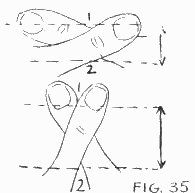
Hold your thumbs so that you have plenty of cord around your thumbs when they are bound together. If you were now to move bases of thumbs apart, you would find that you could easily slip right thumb out of the wire loop.
"There is no doubt but that you have the power of wiring tight. Were you a sailor? Now pass the other cord between my thumbs to make doubly sure that they are well tied."
Have spectator place second cord between thumbs, looping it around to the left and bringing the ends out to the right as shown by Figure 36.
"Wire this second cord together and tight against my thumbs."
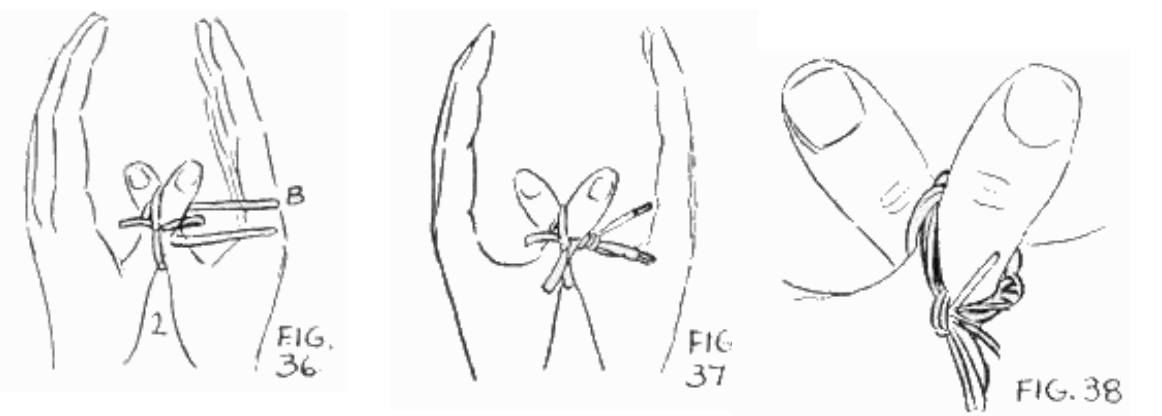
HOLD YOUR THUMBS TIGHT TOGETHER so that it is impossible to get wire twisted between thumbs. In this way you save the extra amount of cord which you have around thumbs.
Spectator twists cord, apparently tight between thumbs. Figure 37.
"Now wire all four ends together at the top."
Assistant twists the four ends of the two cords securely on top of thumbs. Figure 38.
Show thumbs and palms of hands to audience. Turn hands downward and show backs of hands also.
"You are satisfied, are you not, that my thumbs have been securely tied together or rather wired together? You notice that the cords are below the large joints of my thumbs and consequently there is no way that I could release my thumbs."
Ask assistant to take pole and hold it in a vertical position, one end on the floor and the other in his hands.
"Now will you please hold up the pole. Place one end on the floor and hold tightly to the other end with both hands."
Assistant should be standing at right and a little in front of you. Have him hold pole a little to his left and far enough in front of him so that audience gets a good view of it. Figure 39.
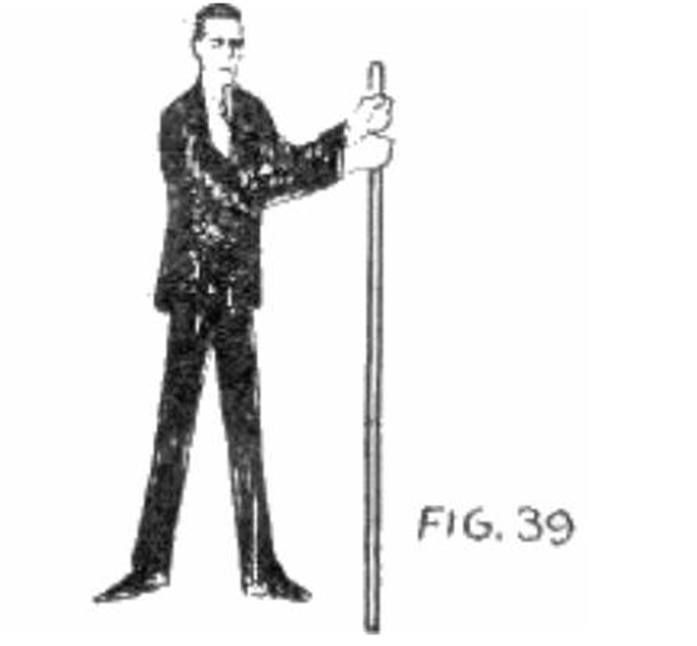
Show hands and thumbs again. Then face assistant.
Your left side and back of left hand is toward audience.
TO TEST THE TIES:
Keep your hands together to screen movements from assistant and from audience.
I want you to test the ties to be sure that you can slip your right thumb out of loop quickly and back in again easily.
Pull down on Cord A by trying to pull right thumb away from left thumb. With fingers of left hand work up Cord B (the one between the thumbs) tight against left thumb. Place second and third fingers of left hand on loop around right thumb and withdraw thumb. Figure 40.
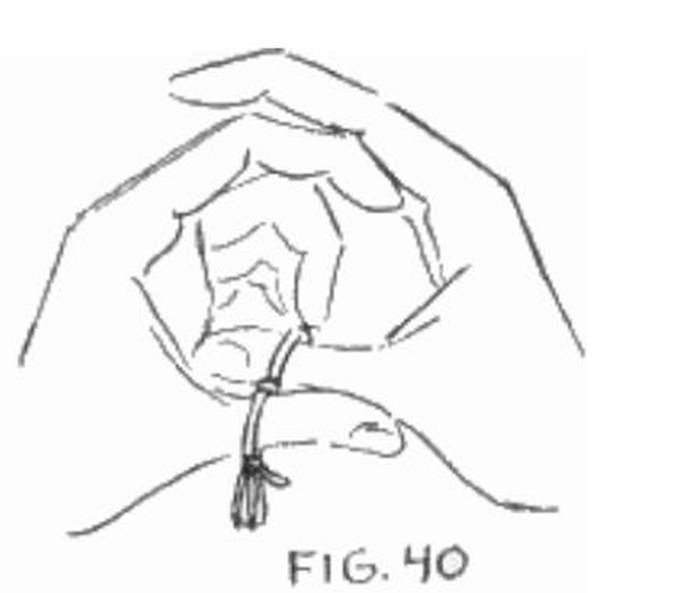
You may aid in getting thumb out of loop by pushing on loop with tips
of fingers of right hand. Figure 41.
When your right thumb is free, you find that you have a loop of the wires around left thumb and a free loop which you use in inserting and withdrawing right thumb. Figure 42.
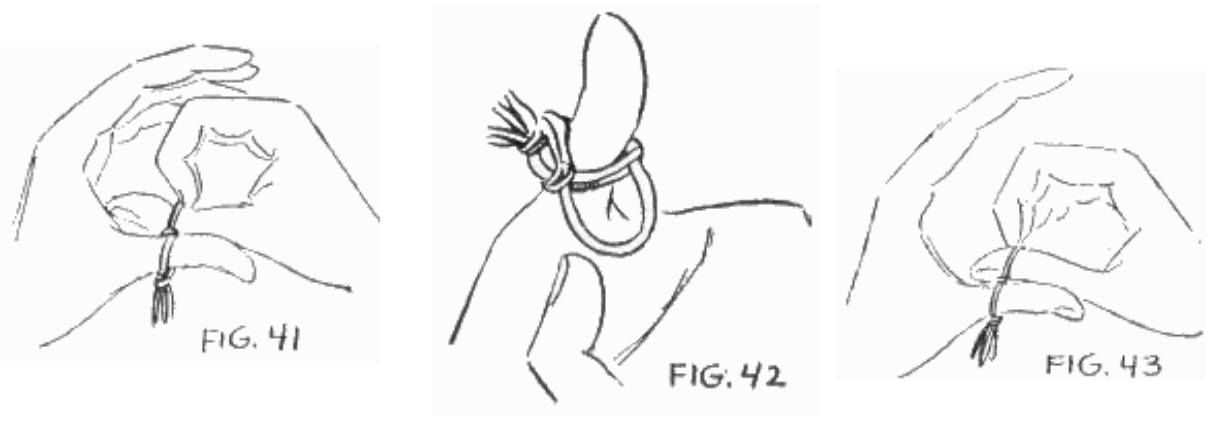
As soon as you have freed your thumb, slip it back into the loop again quickly. Use the tips of fingers of your right hand to help you. Figure. 43.
Then quickly open your hands out flat.
"Will you explain to me, sir, why it is that when my hands are on this side of the pole my arms are away from the pole, but ..."
Put hands up against pole so that your thumbs touch it, then draw hands back toward chest with your finger tips together. Now slip right thumb out of loop.
Suddenly push hands forward again, spreading them just enough to permit them to pass around pole.
The instant thumbs are past pole, insert right thumb into loop again very quickly. Turn backs of hands to audience to show them that thumbs are still tied.
"When my hands are on the other side, my arms are around the pole?"
Swing arms and hands around so that audience and spectator can readily see that arms are really around the pole and that THUMBS ARE STILL TIED. Figure 44.
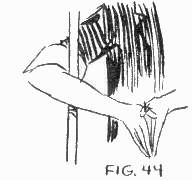
Then suddenly pull your hands back, release right thumb, allowing pole to pass back through hands. Quickly insert thumb back into loop, and show thumbs still tied and pole freed from arms.
"Now the pole is free again, or I am. It is just like this. We are here."
Push hands through pole again and show tied thumbs and arms around pole.
"And here we are there."
Bring arms back to original position, freeing pole.
Hold thumbs up close to assistant to examine.
This illusion is perfect when properly performed. It really appears that pole passes through tied thumbs or solid hands or arms.
"Just set the pole down a moment and take these three rings." Spectator puts down the pole and takes the three rings.
"These rings are made around a circle and I am sure that you will find no ends to them nor any secret openings. There are none. Some people think the rings come apart in some mysterious manner or that there are trap doors in them. Now just toss me a ring."
Stand several feet away from spectator, facing him. He is at your right, therefore audience is to your left when you face him.
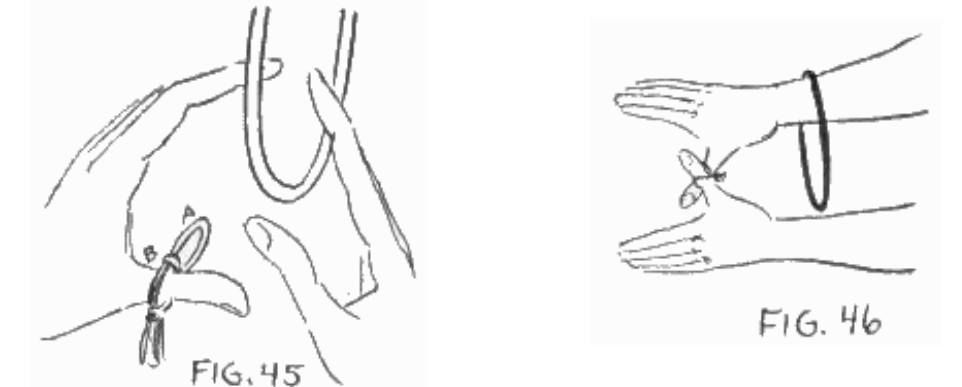
Catch first ring in fingers of both hands. Figure 45.
"Not quite right that time. Throw it again."
As spectator throws ring again, release right thumb from loop, spread hands apart a little and allow ring to pass over onto right arm. Figure 46.
As soon as ring has passed thumbs, insert right thumb back into loop. "Now, see what you have done -- you have thrown the ring right onto my arm." Show thumbs tied and ring on arm.
"Will you please take it off?"
Assistant is, of course, unable to remove ring because of tied thumbs.
"Oh, well, never mind. Just toss me another ring."
Assistant tosses another ring. Catch this on your arm as you did the first one. "I knew you threw that one too quickly. See, here it is on my arm also." Again show thumbs and arms.
"All ready for the last one."
Assistant throws third ring. Catch this one on left arm.
"This ring is left -- that happened because you didn't throw it right. Here I have three rings on my arms, —- bracelets, as it were. But what am I to do with them?"
Drop hands downward so that rings slide down to bases of thumbs and hang down over hands.
"Ah - ha, I have an idea."
Suddenly release right thumb and let rings slide down to tips of fingers outside of thumbs. Insert right thumb immediately in loop again.
Perform this move very smoothly so that assistant and audience will not even notice it and think that rings are still on arms.
"I'll give them to my friend here to wear." Toss rings to assistant.
Show thumbs tied.
"You don't want them? Then we'll lay them aside." Put rings on table.
"Now, place your right hand on my right shoulder."
Assistant does this. Your arms are below his arm. Figure 47.
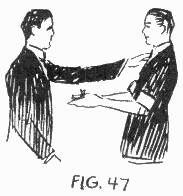
Quickly bring your hands upward and pass them through his arm, releasing thumb. As soon as your hands are above his arm, insert thumb in loop again. Show thumbs tied.
"You see I meant to have your arm under mine, instead of . . ." Bring hands down quickly through arm again.
"Over mine, as it is now."
Show thumbs again, securely tied.
"Please untie my thumbs and notice as you do so that they are secure just as you wired them."
Assistant untwists wires and removes cords.
"There are the marks on my thumbs from the tight wires." Show marks on thumbs caused by binding.
"But that always goes with the experiment. I thank you." Assistant returns to his seat.
NOTE:
The Thumb Tie Principle offers great opportunity for variety in performance. Thumbs can be passed through backs of chairs, through performer's leg, and a variety of objects can be slid onto performer's arms. Try to work out some original angle for the use of this principle. You will find it fascinating.
Devote much time TO PRACTISE OF WITHDRAWING AND INSERTING RIGHT THUMB IN LOOP.
Get it down so well that there is but an instant between release of thumb and retying. Ten Ichi and Asahi work it like a flash. Practice this move at home. Have someone tie you several times and then go into another room and repeatedly practice withdrawing and inserting right thumb in loop. DO NOT EXPOSE THE MOVE to the one who is tying you.
TO MAKE JAPANESE CORDS FOR TYING:
Get some cord about one-eighth to three-sixteenths of an inch in diameter and about eleven inches long.
Take a strip of heavy parchment or gloss tissue paper or genuine rice paper, if you can secure any about an inch wide. Cut this material into inch strips.
Roll the paper around the cord diagonally, overlapping each turn a little to cover the cord completely. Twist the ends of paper to hold it on cord securely. Figure 48.
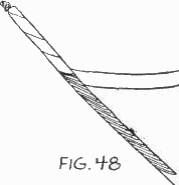
Prepare another cord in the same way. To make the working of the principle easy, the cords must be fairly stiff. That's why pipe cleaners work so satisfactorily. Wrapping paper around cord makes them fairly stiff and suitable for performing the move.
This thumb tie which I have given you is one of the best methods known and is especially good because of its impromptu nature. Perfect yourself in performing it.
Later on in the course under Japanese Magic I will teach you another Japanese Thumb Tie in which the thumbs are tied separately and rings are passed onto the arms without slipping the thumbs from their ties.
TARBELL SYSTEM, INCORPORATED, Chicago.
LESSON 12
In your next lesson I am going to teach you three great classics in Card Magic:
1--Twelve cards are counted into each of performer's hands. Twelve of these are wrapped in a handkerchief and given to spectator to hold. The other twelve are given to another spectator. Someone in audience selects a small number. Performer causes the exact number of cards chosen to fly mysteriously from the twelve held by one spectator to the twelve wrapped in the handkerchief and held by the other spectator.
2--Twelve cards are counted out and placed in magician's left hand. Performer shows right trousers' pocket to be empty. Then he causes cards from left hand to travel invisibly into right trousers' pocket one at a time. Spectator is asked to reach into pocket and remove card from time to time.
3--A number of cards are counted into magician's left hand. One by one he causes them to pass up his left sleeve and produces them from his shoulder.
Bạn đang đọc truyện trên: truyentop.pro